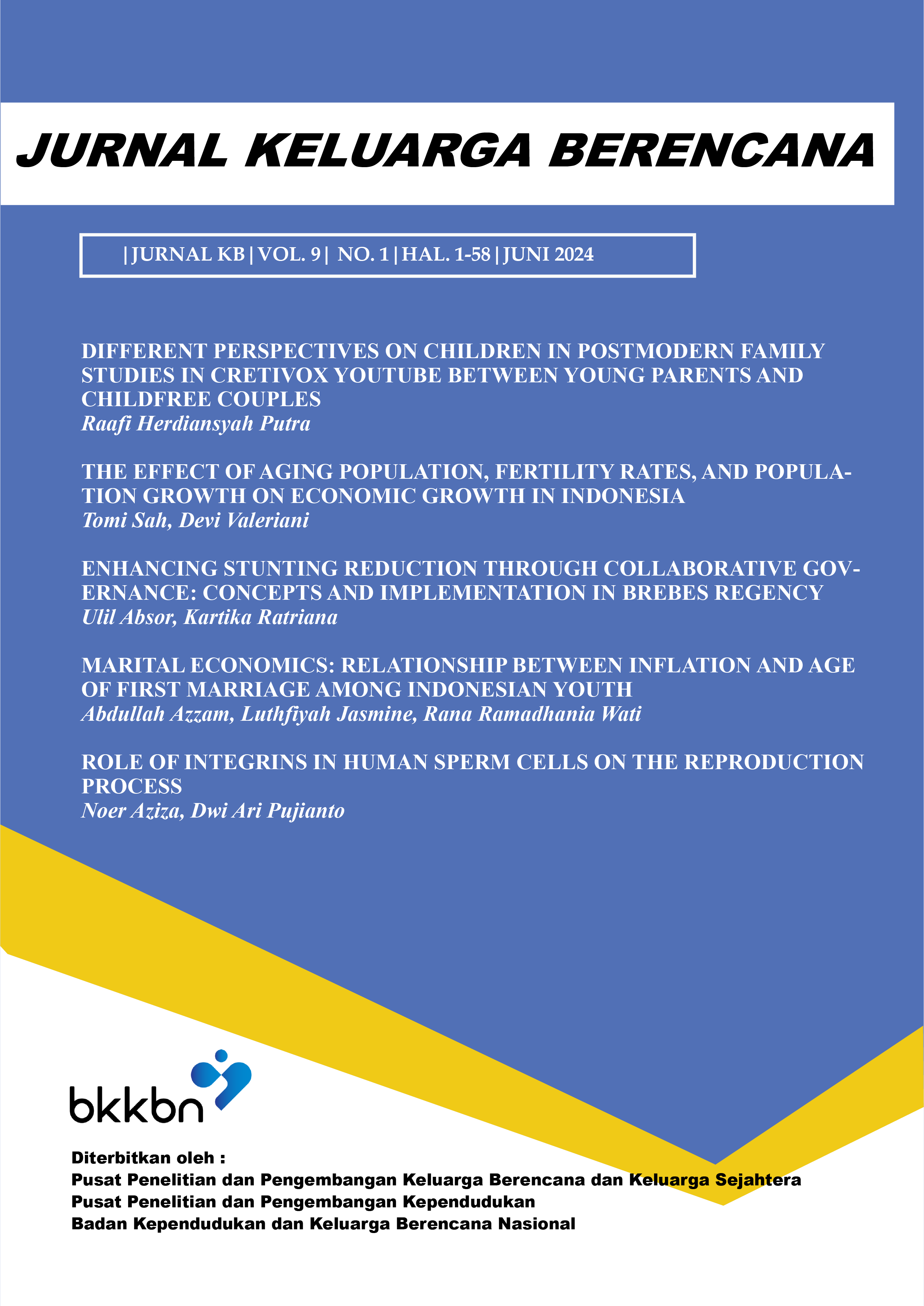MARITAL ECONOMICS: RELATIONSHIP BETWEEN INFLATION AND AGE OF FIRST MARRIAGE AMONG INDONESIAN YOUTH
DOI:
https://doi.org/10.37306/mqsp4y26Keywords:
Inflation, Economy, Marriage, Pressure, YouthAbstract
Economic factors, including inflation, have long been recognized as significant determinants of marital patterns and decisions. Previous studies have shown mixed results on how economic instability and inflation affect marriage rates, with some findings indicating a deterrent effect due to increased economic uncertainty, while others show varying impacts across different regions and timeframes. However, existing literature often lacks contemporary analysis within specific geographical contexts, such as Indonesia, and does not extensively explore the compounded annual effects of inflation on marriage rates. This study addresses these gaps by examining the relationship between compounded inflation rates and the age of first marriage among Indonesian youth from 2019 to 2023. Utilizing national and subgroup data from the “Statistik Pemuda Indonesia” dataset provided by the Central Agency of Statistics (BPS), including distinctions by gender, rural vs. urban settings, and expense groups, this paper provides a nuanced analysis of how recent economic conditions influence marital decisions. The results of the Shapiro-Wilk test conducted across the dataset are mixed. Due to this inconsistency, the use of the Spearman Rank Correlation and Pearson Correlation is justified. The results reveal significant variances in how different demographic segments react to economic pressures, thereby enriching our understanding of the economic factors driving marital choices in contemporary Indonesian society. Through this analysis, the study contributes to the broader discourse on marital economics by integrating localized economic metrics with demographic behavioral patterns, offering valuable insights for policymakers and social scientists.
Downloads
References
Annur, C. M. (2024, February). Angka Pernikahan Turun pada 2023, Rekor Terendah Sedekade Terakhir. Databooks.
Blackburn, S., & Bessell, S. (1997). Marriageable Age: Political Debates on Early Marriage in Twentieth-Century Indonesia. Indonesia, 63, 107. https://doi.org/10.2307/3351513
Bowmaker, S. W., & Emerson, P. M. (2015). Bricks, mortar, and wedding bells: Does the cost of housing affect the marriage rate in the US? Eastern Economic Journal, 41(3), 411–429. https://doi.org/10.1057/eej.2014.24
Dew, J. (2021). Ten Years of Marriage and Cohabitation Research in the Journal of Family and Economic Issues. Journal of Family and Economic Issues, 42(S1), 52–61. https://doi.org/10.1007/s10834-020-09723-7
Fairfax, C. N. (2014). Social Work, Marriage, and Ethnicity: Policy and Practice. Journal of Human Behavior in the Social Environment, 24(2), 83–91. https://doi.org/10.1080/10911359.2014.848669
Fatoureh Bonab, A. (2019). A review of inflation and economic growth. Journal of Management and Accounting Studies, 5(02), 1–4. https://doi.org/10.24200/jmas.vol5iss02pp1-4
Hill, M. J. (2015). Love in the Time of the Depression: The Effect of Economic Conditions on Marriage in the Great Depression. The Journal of Economic History, 75(1), 163–189. https://doi.org/10.1017/S0022050715000066
International Monetary Funds. (2020). CONSUMER PRICE INDEX MANUAL. International Monetary Fund.
Jelnov, P. (2023). The marriage age U-shape. Journal of Demographic Economics, 89(2), 211–252. https://doi.org/10.1017/dem.2021.27
Narayan, C. L., Narayan, M., Shikha, D., & Shekhar, S. (2015). Indian marriage laws and mental disorders: Is it necessary to amend the legal provisions? Indian Journal of Psychiatry, 57(4), 341. https://doi.org/10.4103/0019-5545.171836
Nobles, J., & Buttenheim, A. (2008). Marriage and Socioeconomic Change in Contemporary Indonesia. In Source: Journal of Marriage and Family (Vol. 70, Issue 4).
Nunley, J. M., & Zietz, J. (2012). The Long-Run Impact of Age Demographics on the U.S. Divorce Rate. The American Economist, 57(1), 65–77. https://doi.org/10.1177/056943451205700106
Omobola, O. C. (2013). Influence of Socio-Economic Change on Marriage Norms in the Yoruba Soiety, in Southwest Nigeria. Academic Journal of Interdisciplinary Studies. https://doi.org/10.5901/ajis.2013.v2n3p139
Rammohan, A., & Johar, M. (2009). The Determinants of Married Women’s Autonomy in Indonesia. Feminist Economics, 15(4), 31–55. https://doi.org/10.1080/13545700903153989
Raymo, J. M., & Park, H. (2020). Marriage Decline in Korea: Changing Composition of the Domestic Marriage Market and Growth in International Marriage. Demography, 57(1), 171–194. https://doi.org/10.1007/s13524-019-00844-9
Schellekens, J., & Gliksberg, D. (2013). Inflation and marriage in Israel. Journal of Family History, 38(1), 78–93. https://doi.org/10.1177/0363199012469954
Treble, J. G. (1994). On the Economic of Marriage. The Economic Journal, 104(224), 693–694.
Ul-Haq, J., Mushtaq, S., Visas, H., & Hye, Q. M. A. (2023). Does economic stress matter for the rising divorce rate in China? A provincial perspective. Nurture, 17(1), 18–28. https://doi.org/10.55951/nurture.v17i1.142
Warne, R. (2017). Correlation. In Statistics for the Social Sciences (4th ed., pp. 329–352). Cambridge University Press.
Wulandari, N. S., Kurniaputri, M. R., & Muhammad, M. (2023). Exploring Monetary Policy Effectiveness in Indonesia’s Inflation: Conventional and Islamic Perspective. Equilibrium: Jurnal Ekonomi Syariah, 11(2), 473–498.
Downloads
Published
Issue
Section
License
Copyright (c) 2024 Abdullah Azzam, Luthfiyah Jasmine, Rana Ramadhania Wati

This work is licensed under a Creative Commons Attribution-NonCommercial-NoDerivatives 4.0 International License.
Deprecated: json_decode(): Passing null to parameter #1 ($json) of type string is deprecated in /var/www/html/ejurnal/plugins/generic/citations/CitationsPlugin.php on line 68







